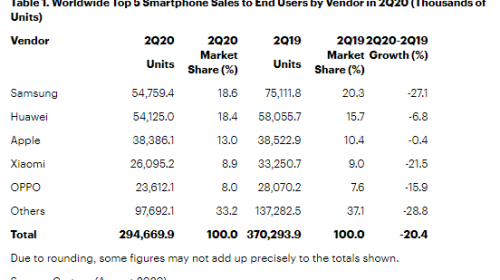Published
4 years agoon

The global mobile smartphone market continued to react to the impacts of Coronavirus on the economy as the market suffered 20 per cent decline in the second quarter of 2020.
Latest data form Gartner Inc., the world’s leading research and advisory company, indicated that during the period under review, worldwide sales of smartphones to end users totaled 295 million units.
Among the top five smartphone vendors, Samsung experienced the largest decline in sales while Apple’s smartphone sales were nearly flat year-over-year.
Although, the report shows that Huawei also declined in smartphone sales year-over-year, it experienced 27.4 per cent growth, quarter-over-quarter, moving it into a virtual tie with Samsung for the number 1 position as the favourite global brand of smartphone.
Almost all major markets, except China, continued to face some form of shelter-in-place restrictions for most of the second quarter of 2020 which led to continued declining smartphone demand, Gartner noted.
“The improved situation in China saw demand recovering quarter- over-quarter,” said Anshul Gupta, senior research director at Gartner.

According to him, travel restrictions, retail closures and more prudent spending on nonessential products during the pandemic led to the second consecutive quarterly decline in smartphone sales this year.
Even with increased demand, smartphone sales in China declined 7 per cent in the the Q2 of 2020, with nearly 94 million smartphones sold.
India which adopted rigorous lockdowns and even restricted e-commerce recorded the worst smartphone sales decline at -46 per cent among the top five countries in the world.
Samsung Recorded Largest Decline Among Top Five Global Smartphone Vendors

Samsung sold nearly 55 million smartphones in the second quarter of 2020, a decline of 27.1 per cent year on year.
Commenting on the development, Mr. Gupta said: “The COVID-19 pandemic continued to negatively affect Samsung’s performance in the second quarter of 2020.” Particularly, demand for its flagship S Series smartphones did little to revive its smartphone sales globally, he observed.
Huawei’s smartphone sales dropped 6.8 per cent and totaled 54 million units year on year.

Despite challenges mounting on it in the United State market, Huawei put in place an aggressive product introduction and sales promotion in China in particular and benefited from the strong support of communications services providers for its 5G smartphones, according to Gupta.
Apple sold 38 million iPhones in the second quarter of 2020, a decline of 0.4 per cent year-over- year.

According to Annette Zimmermann, research vice president at Gartner, Apple’s iPhone sales fared better in the quarter than most smartphone vendors in the market and also grew sales quarter-over-quarter.
Zimmermann added that the improved business environment in China helped Apple achieve growth in the country.
“In addition, the introduction of the new iPhone SE encouraged users of older phones upgrade their smartphones,” he said.
In the global ranking, Xiaomi is occupying the fourth position with 26.095 million units sold in Q2 2020, representing 21.50 per cent decline from the same period of 2019, and 9 per cent fall from the first quarter of 2020. It currently enjoys 8.9 per cent of global smartphone market.
Similarly, OPPO, on the fifth spot sold a total of 23.612 million smartphone units. Its sales fell by 15.9 per cent relative to Q2 of 2019 while it appreciated by 7.6 per cent compared to Q1, 2020. It controls 8 per cent of the global market.
Meanwhile, Gartner data shows that other brands collectively sold 97.692 million units, representing 33.2 per cent market share; 28.8 per cent below Q2 2019 record but 37.1 per cent higher than Q1, 2020 record.














